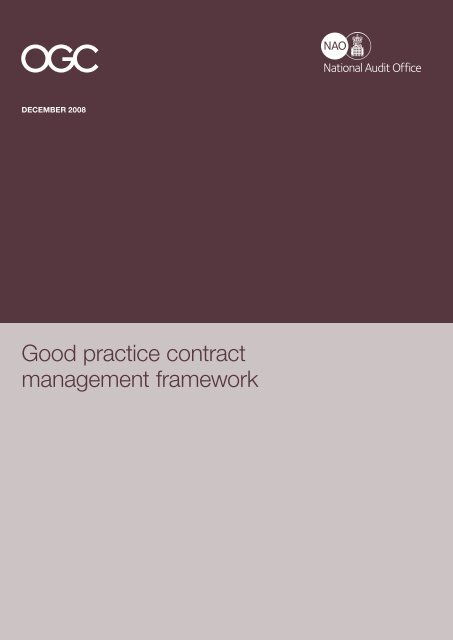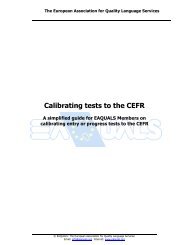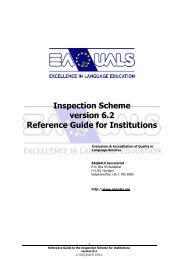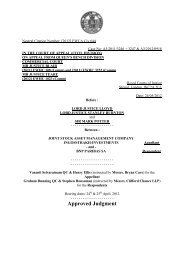Good practice contract management framework - Support
Good practice contract management framework - Support
Good practice contract management framework - Support
Create successful ePaper yourself
Turn your PDF publications into a flip-book with our unique Google optimized e-Paper software.
DECEMBER 2008<br />
<strong>Good</strong> <strong>practice</strong> <strong>contract</strong><br />
<strong>management</strong> <strong>framework</strong>
The National Audit Office scrutinises public spending on behalf of<br />
Parliament. The Comptroller and Auditor General, Tim Burr, is an Officer<br />
of the House of Commons. He is the head of the National Audit Office<br />
which employs some 850 staff. He and the National Audit Office are totally<br />
independent of Government. He certifies the accounts of all Government<br />
departments and a wide range of other public sector bodies; and he has<br />
statutory authority to report to Parliament on the economy, efficiency and<br />
effectiveness with which departments and other bodies have used their<br />
resources. Our work leads to savings and other efficiency gains worth<br />
many millions of pounds; at least £9 for every £1 spent running the Office.<br />
The Office of Government Commerce is an independent office of HM<br />
Treasury, established to help government deliver best value from its<br />
spending. The Office of Government Commerce works with central<br />
government departments and other public sector organisations to ensure<br />
the achievement of six key goals:<br />
<br />
<br />
<br />
<br />
<br />
<br />
delivery of value for money from third party spend;<br />
delivery of projects to time, quality and cost, realising benefits;<br />
getting the best from the Government’s £30 billion estate;<br />
improving the sustainability of the Government estate and operations,<br />
including reducing carbon emissions by 12.5 per cent by 2010-11,<br />
through stronger performance <strong>management</strong> and guidance;<br />
helping achieve delivery of further government policy goals,<br />
including innovation, equality, and support for small and medium<br />
enterprises; and<br />
driving forward the improvement of central government<br />
capability in procurement, project and programme <strong>management</strong>,<br />
and estates <strong>management</strong> through the development of people<br />
skills, processes and tools.
<strong>Good</strong> <strong>practice</strong> <strong>contract</strong><br />
<strong>management</strong> <strong>framework</strong>
This good <strong>practice</strong> <strong>framework</strong> for <strong>contract</strong><br />
<strong>management</strong> (the <strong>framework</strong>) was developed in<br />
parallel with the National Audit Office report on<br />
Central government’s <strong>management</strong> of service<br />
<strong>contract</strong>s and was used during the fieldwork stage<br />
of the report to benchmark central government’s<br />
<strong>contract</strong> <strong>management</strong> performance against<br />
good <strong>practice</strong>. The <strong>framework</strong> will provide the<br />
foundation for the Office of Government Commerce’s<br />
revised guidance on <strong>contract</strong> <strong>management</strong>.
Contents<br />
Overview 4<br />
Section One<br />
The good <strong>practice</strong> <strong>contract</strong><br />
<strong>management</strong> <strong>framework</strong> 6<br />
Section Two<br />
Assessing the appropriate level<br />
of <strong>contract</strong> <strong>management</strong> 17<br />
Section Three<br />
Linking the good <strong>practice</strong><br />
<strong>framework</strong> with the risk and value<br />
opportunity assessment 22<br />
For further information about the<br />
National Audit Office please contact:<br />
National Audit Office<br />
157-197 Buckingham Palace Road<br />
Victoria<br />
London<br />
SW1W 9SP<br />
Tel: 020 7798 7000<br />
Email: enquiries@nao.gsi.gov.uk<br />
For further information about the Office of<br />
Government Commerce please contact:<br />
Office of Government Commerce<br />
1 Horse Guards Road<br />
London<br />
SW1A 2HQ<br />
Tel: 0845 000 4999<br />
Email: ServiceDesk@ogc.gsi.gov.uk<br />
© National Audit Office 2008
4 Overview <strong>Good</strong> <strong>practice</strong> <strong>contract</strong> <strong>management</strong> <strong>framework</strong><br />
Overview<br />
1 This good <strong>practice</strong> <strong>framework</strong> for <strong>contract</strong> <strong>management</strong> (the <strong>framework</strong>) was<br />
developed in parallel with the National Audit Office report on Central government’s<br />
<strong>management</strong> of service <strong>contract</strong>s, which was published in December 2008 (HC 65,<br />
Session 2008-09) and is available at www.nao.org.uk. The <strong>framework</strong> was used<br />
during the fieldwork stage of the report to benchmark central government’s <strong>contract</strong><br />
<strong>management</strong> performance against good <strong>practice</strong>.<br />
2 The National Audit Office found that while there are examples of good <strong>practice</strong>,<br />
central government’s <strong>management</strong> of service <strong>contract</strong>s is not consistently delivering<br />
value for money. The report estimated that better <strong>contract</strong> <strong>management</strong> could<br />
potentially generate savings of between £160 million and £290 million a year across<br />
the organisations surveyed through reduced <strong>contract</strong> expenditure. As well as financial<br />
savings, better <strong>contract</strong> <strong>management</strong> could bring improvements in the quantity and/or<br />
quality of services, the avoidance of service failure, and better <strong>management</strong> of risk.<br />
3 The <strong>framework</strong> is a good <strong>practice</strong> guide for managing a broad range of <strong>contract</strong>s.<br />
It is particularly relevant for <strong>contract</strong>s where services are delivered over a long period<br />
of time (five years plus) where customers need to ensure that service levels and value<br />
for money are maintained over the duration of the <strong>contract</strong>. The <strong>framework</strong> will provide<br />
the foundation for the Office of Government Commerce’s revised guidance on <strong>contract</strong><br />
<strong>management</strong>. The Office of Government Commerce will also develop supplementary<br />
guidance, specifically appropriate to the most complex forms of <strong>contract</strong>, during 2009.<br />
4 The <strong>framework</strong> covers the stage where a <strong>contract</strong> has been signed and the service<br />
is up and running. It does not cover the tendering/<strong>contract</strong> award stage or some of<br />
the specific issues that arise when a <strong>contract</strong> expires or is terminated, for example,<br />
relating to the disposal of equipment or handover to a new supplier. Guidance on these<br />
areas, and on issues such as <strong>contract</strong> <strong>management</strong> skills, is available on the Office of<br />
Government Commerce’s website – www.ogc.gov.uk.
<strong>Good</strong> <strong>practice</strong> <strong>contract</strong> <strong>management</strong> <strong>framework</strong> Overview 5<br />
5 The <strong>framework</strong> complements guidance provided by the Operational Taskforce<br />
within Partnerships UK for the <strong>management</strong> of PFI <strong>contract</strong>s during their operational<br />
phase. The <strong>framework</strong> does not, however, cover all the issues which may arise in<br />
relation to PFI <strong>contract</strong>s, which involve an added degree of complexity, for example in<br />
their arrangements for refinancing, managing <strong>contract</strong> variations, risk allocation and<br />
<strong>contract</strong> termination. Further guidance for managers of PFI <strong>contract</strong>s is available on the<br />
Partnerships UK website – http://www.partnershipsuk.org.uk/PUK-OTF.aspx.<br />
6 The <strong>framework</strong> comprises:<br />
<br />
Section 1 which outlines the activities that organisations should consider when<br />
planning and delivering <strong>contract</strong> <strong>management</strong>;<br />
<br />
Section 2 which discusses how to evaluate the risk and value opportunities<br />
inherent in <strong>contract</strong>s; and<br />
<br />
Section 3 which illustrates how the activities from Section 1 and the evaluation<br />
from Section 2 can be brought together to develop <strong>contract</strong> <strong>management</strong> plans<br />
and priorities.<br />
7 The National Audit Office employed two experienced procurement professionals<br />
to develop the initial <strong>framework</strong>. The <strong>framework</strong> was then tested at four workshops<br />
with representatives from government departments and other public bodies, specialist<br />
procurement organisations, IT suppliers and facilities <strong>management</strong> suppliers.<br />
The <strong>framework</strong> was refined in the light of feedback from the workshops. Further<br />
discussions were then held with the Office of Government Commerce, the Chartered<br />
Institute of Purchasing and Supply, and Partnerships UK to finalise the <strong>framework</strong>.
6 Section One <strong>Good</strong> <strong>practice</strong> <strong>contract</strong> <strong>management</strong> <strong>framework</strong><br />
Section One<br />
The good <strong>practice</strong> <strong>contract</strong><br />
<strong>management</strong> <strong>framework</strong><br />
Introduction<br />
1.1 The <strong>framework</strong> defines the four blocks – structure and resources, delivery,<br />
development, and strategy – comprising 11 areas (Figure 1) that organisations should<br />
consider when planning and delivering <strong>contract</strong> <strong>management</strong>, together with the key<br />
activities that fall under each of the 11 areas.<br />
Figure 1<br />
The good <strong>practice</strong> <strong>contract</strong> <strong>management</strong> <strong>framework</strong><br />
Strategy<br />
Market<br />
<strong>management</strong><br />
Planning and<br />
governance<br />
Structure and<br />
resources<br />
Supplier<br />
relationship<br />
<strong>management</strong><br />
People<br />
Administration<br />
Supplier<br />
development<br />
<strong>Good</strong><br />
<strong>practice</strong><br />
<strong>framework</strong><br />
Relationships<br />
Development<br />
Contract<br />
development<br />
Performance<br />
Risk<br />
Payment<br />
Delivery
<strong>Good</strong> <strong>practice</strong> <strong>contract</strong> <strong>management</strong> <strong>framework</strong> Section One 7<br />
1.2 The focus of the <strong>framework</strong> is on the activities to be undertaken during the<br />
operational phase of the <strong>contract</strong>, i.e. after the <strong>contract</strong> has been awarded and once the<br />
service is up and running. The <strong>framework</strong> has particular relevance to service <strong>contract</strong>s<br />
(covering information and communications technology, facilities <strong>management</strong> and<br />
business processes) where service levels and value have to be maintained and improved<br />
often over long <strong>contract</strong> periods.<br />
Contract <strong>management</strong> in context – the effect of the tendering/<br />
<strong>contract</strong> award phase<br />
1.3 Whilst the <strong>framework</strong> focuses on the operational phase of the <strong>contract</strong>, <strong>contract</strong><br />
<strong>management</strong> success and the activities undertaken are strongly influenced by what has<br />
happened during the tendering/<strong>contract</strong> award phase, in terms of both ‘hard’ outputs,<br />
such as the terms and conditions that have been agreed, and the type of relationship<br />
between customer and supplier that has been established during the tendering/<br />
<strong>contract</strong> award phase. In this way, the tendering/<strong>contract</strong> award phase and the <strong>contract</strong><br />
<strong>management</strong> phase should be seen as a continuum rather than distinct phases, with<br />
<strong>contract</strong> <strong>management</strong> planned for from the start of the procurement process. Some of<br />
the key issues that can influence <strong>contract</strong> <strong>management</strong> include the following.<br />
<br />
Whether <strong>contract</strong> <strong>management</strong> staff have been involved in the earlier tendering/<br />
<strong>contract</strong> award phase.<br />
<br />
The style of the tendering process. An adversarial tendering process may lead to<br />
a more adversarial or confrontational relationship during the <strong>contract</strong> <strong>management</strong><br />
phase, although good working relationships between the staff on both sides<br />
who will manage the <strong>contract</strong> can be developed at the same time that separate,<br />
sometimes tough, negotiations are taking place to finalise the <strong>contract</strong>.<br />
<br />
The ‘cultural fit’ between customer and supplier. For example, if one party feels<br />
comfortable working in a very process-driven, detailed manner, while the other<br />
prefers a more open, high-level relationship, then developing successful <strong>contract</strong><br />
<strong>management</strong> will be more challenging.<br />
<br />
A <strong>contract</strong> where one party feels they are disadvantaged by the terms and<br />
conditions, or the commercial terms, of the <strong>contract</strong> may lead to more adversarial<br />
<strong>contract</strong> <strong>management</strong>.<br />
<br />
Key hard outputs that have a major impact on the design and effectiveness of<br />
<strong>contract</strong> <strong>management</strong> – such as key performance indicators and service level<br />
agreements – are often determined during the tendering/<strong>contract</strong> award phase.
8 Section One <strong>Good</strong> <strong>practice</strong> <strong>contract</strong> <strong>management</strong> <strong>framework</strong><br />
The <strong>framework</strong><br />
1.4 The key activities to be undertaken under each of the 11 <strong>contract</strong> <strong>management</strong><br />
areas are set out below. The numbering is not intended to indicate that the activities<br />
should be executed in a sequential manner. Indeed, many of the areas and activities are<br />
relevant throughout the <strong>contract</strong> <strong>management</strong> phase.<br />
1.5 As discussed in more detail in Sections 2 and 3, not all of the 11 areas are equally<br />
relevant to all <strong>contract</strong>s. Generally, the more developmental and strategic areas and<br />
activities (areas 8 to 11) become increasingly important the higher the <strong>contract</strong> risk and<br />
the greater the opportunity to add value.<br />
Structure and resources<br />
Area 1: Planning and governance<br />
Preparing for <strong>contract</strong> <strong>management</strong> and providing oversight<br />
1.1 There is a planned transition from the tendering/<strong>contract</strong> award phase to the <strong>contract</strong> <strong>management</strong><br />
phase, and a handover to <strong>contract</strong> manager; the cost of <strong>contract</strong> <strong>management</strong> is included in the<br />
business case and budgets.<br />
1.2 Contract ownership is clear, with the budget holder, senior responsible owner (SRO), and <strong>contract</strong><br />
manager clearly defined; there is continuity of governance as far as possible.<br />
1.3 There are well defined processes and a clear <strong>contract</strong> <strong>management</strong> plan, with a focus on outputs<br />
and a ‘whole life’ approach to performance.<br />
1.4 Overall ownership of <strong>contract</strong> <strong>management</strong> across the organisation is clear, with a ‘<strong>contract</strong><br />
<strong>management</strong> senior responsible owner’ with responsibility for driving organisation-wide <strong>contract</strong><br />
<strong>management</strong> performance.<br />
1.5 Contract <strong>management</strong> processes are aligned with, among others, wider organisational governance<br />
processes, operational boards, and risk structures.<br />
1.6 Contract <strong>management</strong> issues and performance are reported through the governance structure with<br />
senior level engagement.<br />
1.7 Regular assessment and evaluation takes place to ensure that the cost of <strong>contract</strong> <strong>management</strong><br />
activities is justified and proportionate to the benefits obtained.<br />
1.8 Knowledge <strong>management</strong> is embedded, capturing key data and lessons from <strong>contract</strong> <strong>management</strong><br />
process and experience both within the organisation and more widely.<br />
1.9 Professional <strong>contract</strong> <strong>management</strong> guidance is developed, or identified from external sources, and<br />
made available to <strong>contract</strong> managers.
<strong>Good</strong> <strong>practice</strong> <strong>contract</strong> <strong>management</strong> <strong>framework</strong> Section One 9<br />
Area 2: People<br />
Ensuring the right people are in place to carry out the <strong>contract</strong><br />
<strong>management</strong> activities<br />
The <strong>contract</strong> manager (or <strong>contract</strong> <strong>management</strong> team)<br />
2.1 The <strong>contract</strong> manager has continuity (ideally through involvement during the tendering/<strong>contract</strong><br />
award processes) and a handover from the staff responsible for the tendering/<strong>contract</strong> award.<br />
2.2 The <strong>contract</strong> manager has a detailed knowledge of the <strong>contract</strong> and other relevant issues, such as<br />
service level agreements, and ongoing supplier performance.<br />
2.3 The <strong>contract</strong> manager has the appropriate skills (both specific <strong>contract</strong> <strong>management</strong> skills and more<br />
general commercial awareness and expertise), with access to relevant training and development.<br />
Experienced <strong>contract</strong> managers are utilised on key <strong>contract</strong>s.<br />
2.4 Contract managers have accurate job descriptions, roles are positioned at an appropriate level and<br />
salary, and there is a career path for <strong>contract</strong> <strong>management</strong> staff.<br />
2.5 Contract managers have clear objectives and reporting lines and their performance is managed<br />
through reviews and appraisals.<br />
2.6 The <strong>contract</strong> manager has appropriate delegated authority to manage the <strong>contract</strong> effectively.<br />
Wider staff issues<br />
2.7 Balanced <strong>contract</strong> <strong>management</strong> teams are brought together, with an appropriate range of skills; the<br />
teams may vary in composition over the life of the <strong>contract</strong> to meet specific needs.<br />
2.8 Contract <strong>management</strong> is adequately resourced, in proportion to the importance of the <strong>contract</strong><br />
(primarily but not exclusively its cost), and there are enough staff to carry out the required activities.<br />
2.9 The organisation has a <strong>contract</strong> <strong>management</strong> ‘community’ allowing <strong>contract</strong> managers to share<br />
good <strong>practice</strong>. The community also plays a role in the wider government <strong>contract</strong> <strong>management</strong>/<br />
procurement community.<br />
Area 3: Administration<br />
Managing the physical <strong>contract</strong> and the timetable for making key decisions<br />
3.1 Hard copy <strong>contract</strong>s are stored and logged, and are easily accessible when required; for complex<br />
<strong>contract</strong>s, a summary and/or <strong>contract</strong> operations guide is produced.<br />
3.2 Contract <strong>management</strong> software is used for recording key information, to give, for example, search<br />
capability; relevant ongoing <strong>contract</strong> <strong>management</strong> information and documentation is retained<br />
and managed.<br />
3.3 There are mechanisms in place for identifying key <strong>contract</strong> ‘trigger points’, such as notice periods.<br />
3.4 There is regular and ad hoc reporting of <strong>contract</strong> <strong>management</strong> information.<br />
3.5 There are mechanisms in place for handling administration around <strong>contract</strong> closure or termination.<br />
3.6 The customer considers the cost of <strong>contract</strong> <strong>management</strong> activities to the supplier, and the cost is<br />
proportionate to the <strong>contract</strong> size and risk.
10 Section One <strong>Good</strong> <strong>practice</strong> <strong>contract</strong> <strong>management</strong> <strong>framework</strong><br />
Delivery<br />
Area 4: Managing relationships<br />
Developing strong internal and external relationships that facilitate delivery<br />
Roles and responsibilities<br />
4.1 The <strong>contract</strong> manager understands his/her own role and has clear visibility of well-structured roles<br />
and responsibilities on the supplier side.<br />
4.2 The respective responsibilities of the <strong>contract</strong> manager and the supplier are clear, and potentially<br />
defined in a ‘joint statement of intent’ or similar document.<br />
Continuity and communications<br />
4.3 Continuity of key supplier staff is desirable (ideally through involvement during the sales<br />
process); where this cannot be achieved, there is a handover from the staff responsible for the<br />
tendering process.<br />
4.4 Both regular structured and informal communication routes between the <strong>contract</strong> manager and<br />
supplier are open and used; customer and supplier staff are co-located where appropriate.<br />
4.5 Users are given clear expectations and an understanding of the <strong>contract</strong> and the services/<br />
performance to be delivered (for example, through newsletters or briefings).<br />
4.6 Communications between the <strong>contract</strong> manager, supplier and other stakeholders (users of the<br />
<strong>contract</strong> and others such as technical experts) are effective; and stakeholders are involved in<br />
<strong>contract</strong> <strong>management</strong> processes where appropriate.<br />
4.7 Problem resolution processes are well defined and used, and are designed to ensure minor<br />
problems do not escalate and cause relationship issues; a ‘blame culture’ is avoided (for example,<br />
through the use of a ‘relationships charter’ or similar document).
<strong>Good</strong> <strong>practice</strong> <strong>contract</strong> <strong>management</strong> <strong>framework</strong> Section One 11<br />
Area 5: Managing performance<br />
Ensuring the service is provided in line with the <strong>contract</strong><br />
Service delivery<br />
5.1 Service <strong>management</strong> is well structured; baselines are understood by both parties, and suppliers<br />
understand the service they are required to deliver. The <strong>contract</strong> manager ensures that the<br />
customer organisation provides the supplier with the information and contacts needed to deliver<br />
the service.<br />
5.2 A performance <strong>management</strong> <strong>framework</strong> is in place when the <strong>contract</strong> is signed. The <strong>framework</strong><br />
is comprehensive, objective and provides incentives for the supplier to meet or exceed agreed<br />
performance standards.<br />
5.3 Service levels agreements are in place, and are linked to business needs, understood by the<br />
supplier, and monitored by the <strong>contract</strong> manager and/or end users.<br />
5.4 Supplier performance is assessed using clear, objective and meaningful metrics, linked where<br />
appropriate to the Office of Government Commerce’s ‘Common Assessment Framework’ for<br />
monitoring suppliers.<br />
5.5 Reporting is as far as possible on a focused, ‘by exception’ basis, with supplier self-measurement<br />
and reporting where appropriate but with independent checking mechanisms to alert the customer<br />
to performance issues (for example, user feedback).<br />
5.6 Clear processes are in place to handle operational problem resolution and resolve issues as quickly<br />
as possible.<br />
5.7 Where appropriate, user compliance with the <strong>contract</strong> is monitored and managed to ensure<br />
maximum operational effectiveness and value for money.<br />
Feedback and communications<br />
5.8 Regular and routine feedback is given to suppliers on their performance.<br />
5.9 There are clear contact points for service users both within the supplier organisation and with the<br />
<strong>contract</strong> manager. Users understand what the <strong>contract</strong> is intended to deliver, and are involved in<br />
the assessment of supplier performance where relevant. Users understand escalation routes where<br />
issues arise.<br />
5.10 Changes in user requirements are captured and considered as part of formal change and <strong>contract</strong><br />
<strong>management</strong> processes.<br />
5.11 There are formal performance reviews with suppliers, with documented improvement plans agreed<br />
where necessary, covering both operational issues and adherence to key <strong>contract</strong>ual requirements,<br />
for example, on data security.
12 Section One <strong>Good</strong> <strong>practice</strong> <strong>contract</strong> <strong>management</strong> <strong>framework</strong><br />
Area 6: Payment and incentives<br />
Ensuring payments are made to the supplier in line with the <strong>contract</strong> and that<br />
appropriate incentive mechanisms are in place and well managed<br />
Payment and budgets<br />
6.1 Payment mechanisms are documented and are clear and well understood by all parties (including<br />
incentives, penalties, and non standard charges).<br />
6.2 Payment processes are well defined and efficient; appropriate checks and authorisation processes<br />
are in place for paying invoices.<br />
6.3 The costs of the services delivered and <strong>contract</strong> <strong>management</strong> costs are mapped against budgets<br />
and allocated appropriately.<br />
6.4 Payment changes after the <strong>contract</strong> is let, for example from <strong>contract</strong> variations or benchmarking/<br />
market testing, are made using <strong>contract</strong>ual provisions and demonstrated to provide value for money.<br />
Payment and incentive mechanisms<br />
6.5 Incentive structures (financial or non-financial) relate clearly to desired outcomes, and are well<br />
managed and governed, with appropriate checks and approval mechanisms.<br />
6.6 Service credits or equivalent mechanisms are well managed and governed, and proportionate to<br />
supplier profitability.<br />
6.7 Where open-book or similar financial/pricing mechanisms are used, the process is managed<br />
professionally and fairly.<br />
6.8 The <strong>contract</strong> manager takes action where necessary to avoid the organisation being ‘locked in’ to<br />
onerous commercial terms throughout the <strong>contract</strong> period, such as price escalation or ‘compulsory’<br />
maintenance payments.
<strong>Good</strong> <strong>practice</strong> <strong>contract</strong> <strong>management</strong> <strong>framework</strong> Section One 13<br />
Area 7: Risk<br />
Understanding and managing <strong>contract</strong>ual and supplier risk<br />
Processes and plans<br />
7.1 Contractual/supplier risk <strong>management</strong> is in place with clear responsibilities and processes,<br />
identification of who is best placed to manage risk, and supplier involvement where appropriate.<br />
7.2 Risks are formally identified and monitored regularly, with mitigating actions developed and<br />
implemented where possible, and ‘obsolete’ risks removed from consideration where appropriate.<br />
7.3 Escalation and reporting routes are in place for risk governance.<br />
7.4 Contingency plans are developed to handle supplier failure (temporary or long-term failure/default);<br />
exit strategies are developed and updated through the life of the <strong>contract</strong>.<br />
Contractual terms<br />
7.5 Contractual terms around termination are understood and monitored by the <strong>contract</strong> manager.<br />
7.6 Contractual terms around warranties, indemnities and insurance are understood and monitored by<br />
the <strong>contract</strong> manager.<br />
7.7 Contractual terms around security and confidentiality are understood and monitored by the<br />
<strong>contract</strong> manager, particularly issues relating to the security/confidentiality of personal data.<br />
7.8 Dispute resolution processes are in place, including agreed adjudication procedures, mediation,<br />
and arbitration.<br />
Ongoing supplier risk <strong>management</strong><br />
7.9 The <strong>contract</strong> manager monitors the supplier’s financial health and business performance (including<br />
through the use of credit rating agencies).<br />
7.10 The <strong>contract</strong> manager monitors the supplier’s compliance with <strong>contract</strong>ual ‘non-performance’<br />
issues (for example, on tax and sustainability targets).
14 Section One <strong>Good</strong> <strong>practice</strong> <strong>contract</strong> <strong>management</strong> <strong>framework</strong><br />
Development<br />
Area 8: Contract development<br />
Effective handling of changes to the <strong>contract</strong><br />
Change processes<br />
8.1 The <strong>contract</strong> is regularly reviewed (with a view to updating where necessary) to ensure it meets<br />
evolving business needs.<br />
8.2 Processes are in place that clearly lay out the governance of <strong>contract</strong>ual change – who<br />
needs to approve what and how it will happen – with a focus on effective and prompt<br />
change implementation.<br />
8.3 There are clear processes for the <strong>management</strong> of minor changes and <strong>contract</strong> variations, with a<br />
focus on the cost/effort being proportionate to the importance and value of the change.<br />
8.4 There are more rigorous processes to handle major <strong>contract</strong>ual changes, including clear approval<br />
mechanisms and accountabilities, and controls to demonstrate that changes offer value for money.<br />
8.5 Where appropriate, value for money testing of existing services takes place through benchmarking<br />
or other processes.<br />
8.6 There are processes to cover the introduction of new services under the <strong>contract</strong>, including market<br />
testing where necessary.<br />
8.7 Dispute handling processes are in place to handle change related issues.<br />
Processes for different types of change<br />
8.8 Both parties have a clear understanding of the arrangements for any extension of the <strong>contract</strong> (both<br />
scope and time) and related issues.<br />
8.9 Processes are in place to handle commercial (financial) changes to the <strong>contract</strong> in a fair and<br />
structured manner.<br />
8.10 Price changes are managed fairly and effectively with the use of mechanisms such as<br />
benchmarking, competitive tendering (for example, for major additional works), or other techniques<br />
such as open book pricing as appropriate, to test value for money.<br />
8.11 The rationalisation of specifications and demand <strong>management</strong> are considered as options to achieve<br />
better value for money.
<strong>Good</strong> <strong>practice</strong> <strong>contract</strong> <strong>management</strong> <strong>framework</strong> Section One 15<br />
Area 9: Supplier development<br />
Improving supplier performance and capability<br />
Processes<br />
9.1 Processes are in place that clearly set out how supplier development activities will be planned,<br />
managed and governed.<br />
9.2 Clear processes for benefits measurement and capture are in place to ensure that<br />
supplier development is focused on continuous improvement and achieving value for the<br />
customer organisation.<br />
9.3 The customer organisation understands what motivates and drives the supplier and how supplier<br />
development fits with the supplier’s goals.<br />
Improvement activities<br />
9.4 Supplier operational performance improvement activities (for example, ‘Lean’ and ‘6-sigma’), with<br />
potential input or assistance provided by the customer organisation.<br />
9.5 Joint working or shared activities between the two parties for the benefit of both the supplier and<br />
customer (for example, process improvement, shared training, task forces or joint project teams).<br />
9.6 Supplier improvement activities relating to wider government initiatives, with input or assistance<br />
provided by the customer organisation (for example, on sustainability, disability employment issues,<br />
use of SMEs (Small and Medium Sized Enterprises) and BMEs (Black Minority Ethnic suppliers)).<br />
9.7 Shared risk reduction programmes or activities.<br />
9.8 Supply chain development activities (for example, the development of second/third tier<br />
supplier performance).<br />
9.9 Shared <strong>management</strong> activities (for example, supplier boards) to drive performance improvement.
16 Section One <strong>Good</strong> <strong>practice</strong> <strong>contract</strong> <strong>management</strong> <strong>framework</strong><br />
Strategy<br />
Area 10: Supplier relationship <strong>management</strong><br />
Having a programme for managing and developing relationships with suppliers<br />
10.1 A supplier relationship <strong>management</strong> programme is planned and structured with appropriate<br />
governance and senior ownership.<br />
10.2 A benefits realisation plan is in place for supplier relationship <strong>management</strong>; there is a clear sense of<br />
what value is to be generated for both parties.<br />
10.3 There is a focus on capturing innovation from the supplier where necessary or valuable.<br />
10.4 Knowledge <strong>management</strong> issues are addressed, including knowledge capture from suppliers.<br />
10.5 The supplier relationship <strong>management</strong> programme considers all the supplier’s interactions<br />
across an organisation and on a pan-government basis, including work with the Office of<br />
Government Commerce.<br />
10.6 Board level supplier/customer organisation interfaces and relationships are planned and managed<br />
in line with overall supplier relationship <strong>management</strong> objectives.<br />
Area 11: Market <strong>management</strong><br />
Managing the wider market issues that impact on the <strong>contract</strong>, but lie<br />
beyond the supplier<br />
11.1 Processes are in place to evaluate and review options around delivering services in-house<br />
or outsourcing.<br />
11.2 Market intelligence is used to maintain an understanding of the market and of alternative suppliers<br />
(to inform benchmarking, contingency planning and re-competition strategies).<br />
11.3 The capacity and capability of potential suppliers is analysed, and linked to wider government<br />
analysis, for example, by the Office of Government Commerce.<br />
11.4 There is ongoing evaluation of emerging technologies and <strong>practice</strong>s, and identification of<br />
opportunities from both immediate and parallel market sectors.<br />
11.5 Market making is undertaken where appropriate to stimulate competition and ensure the<br />
requirements can be delivered by the market; there is an understanding of issues such as switching<br />
and bidding costs.<br />
11.6 A re-competition strategy and plan is put in place in a timely manner; the <strong>contract</strong> manager feeds<br />
into strategy development for the ‘new’ procurement process.
<strong>Good</strong> <strong>practice</strong> <strong>contract</strong> <strong>management</strong> <strong>framework</strong> Section Two 17<br />
Section Two<br />
Assessing the appropriate level of<br />
<strong>contract</strong> <strong>management</strong><br />
2.1 As set out in Section 1, the <strong>framework</strong> comprises 11 <strong>contract</strong> <strong>management</strong> areas<br />
and over 80 key activities that organisations should be considering when managing<br />
a <strong>contract</strong>. However, not all of these areas and activities are relevant for every service<br />
<strong>contract</strong>. The level of resources devoted to <strong>contract</strong> <strong>management</strong> and the type of<br />
activities undertaken should be proportionate and justified by the potential benefits they<br />
may deliver.<br />
2.2 For each <strong>contract</strong>, organisations therefore need to assess the potential benefits of<br />
<strong>contract</strong> <strong>management</strong>. This can be done using two dimensions.<br />
<br />
The benefit that can be obtained from effectively managing the risk inherent in<br />
the <strong>contract</strong>.<br />
<br />
The potential additional value that can be obtained from effective<br />
<strong>contract</strong> <strong>management</strong>.<br />
2.3 As the level of risk increases, the benefits which may be derived from reducing<br />
these risks through enhanced <strong>contract</strong> <strong>management</strong> also increase. A <strong>contract</strong> that has<br />
little inherent risk attached to it and little opportunity for additional value would not need<br />
or justify a large amount of <strong>contract</strong> <strong>management</strong> resources, as the benefits that could<br />
be achieved from greater <strong>contract</strong> <strong>management</strong> would be small. This may be the case<br />
even if the annual expenditure on a <strong>contract</strong> is substantial, although small improvements<br />
on a major <strong>contract</strong> can, of course, be significant.<br />
2.4 Even if <strong>contract</strong> risk is low, the potential to generate additional value from the<br />
<strong>contract</strong> can justify increasing levels of <strong>contract</strong> <strong>management</strong> resources and activities.<br />
Extra value could come, for example, from cost reduction through process development,<br />
or from persuading a supplier to increase service levels without additional cost.
18 Section Two <strong>Good</strong> <strong>practice</strong> <strong>contract</strong> <strong>management</strong> <strong>framework</strong><br />
Managing <strong>contract</strong> risks<br />
(a) Identifying <strong>contract</strong> risks<br />
2.5 The initial stage in any risk <strong>management</strong> process is to identify the key risks. In the<br />
case of service <strong>contract</strong>s, the key risks can be categorised into three broad areas.<br />
<br />
Service failure – the most obvious and common risk is that the supplier does<br />
not deliver the service to the standard or timeliness specified in the <strong>contract</strong>.<br />
Service failure can range from a relatively minor shortfall against required service<br />
levels to complete failure. Minor failure could be driven by, for example, the<br />
customer providing unclear specifications, a lack of supplier capability, or a supplier<br />
cutting corners to improve profitability. At the extreme, financial or other problems<br />
could cause the supplier to go out of business, unilaterally withdraw from the<br />
<strong>contract</strong>, or be unable to deliver the service.<br />
<br />
Reputational damage – even if the service is provided as specified in the<br />
<strong>contract</strong>, there is a further risk that the supplier in some manner causes harm to<br />
the customer organisation’s reputation. For example, the supplier may act illegally<br />
or in a manner that conflicts with government policy. Supplier problems could result<br />
in sensitive or personal information not being kept secure, or a supplier may be<br />
dealing with vulnerable citizens where poor performance would have operational<br />
implications and cause reputational damage to the customer organisation.<br />
<br />
Additional cost – this category of risk covers cases where the <strong>contract</strong> costs<br />
more than expected or budgeted, and those costs do not represent value for<br />
money. The amounts paid to the supplier may increase as a result of changes<br />
in the quantity or quality of the services delivered or their prices. For example,<br />
user demand may be higher than expected. In such cases, additional costs<br />
may be reasonable and offer value for money. But it is vital that processes are<br />
well managed so that value for money is tested and achieved on this additional<br />
expenditure. The internal costs of the customer organisation may also increase.<br />
For example, poor user perception of the service could lead to more work being<br />
done internally by the customer’s staff rather than by the supplier, with consequent<br />
additional costs.<br />
(b) Quantifying <strong>contract</strong> risks<br />
2.6 Once the core risks associated with a <strong>contract</strong> have been identified, the scale<br />
or importance of each risk needs to be quantified. This can be done by assessing<br />
two elements.<br />
<br />
The likelihood (probability) of the risk materialising.<br />
<br />
The impact if the risk does materialise.
<strong>Good</strong> <strong>practice</strong> <strong>contract</strong> <strong>management</strong> <strong>framework</strong> Section Two 19<br />
The likelihood of the risk (probability)<br />
2.7 Understanding the likelihood of the risk materialising is key to assessing its relative<br />
importance. A risk may have a huge potential impact, but if the likelihood of it happening<br />
is very small, it may not be worth devoting much effort to managing or reducing the risk.<br />
In terms of service <strong>contract</strong>s, a variety of factors can influence the likelihood of the key<br />
risks materialising.<br />
<br />
The technical or operational complexity of the services being delivered.<br />
<br />
The complexity of the terms and conditions of the <strong>contract</strong>. More complex, or<br />
non-standard, terms and conditions require more effort to understand, control and<br />
update than do concise or standard terms and conditions.<br />
<br />
The number of changes required to the <strong>contract</strong> over its duration.<br />
<br />
The number of internal users or other stakeholders within the<br />
customer organisation.<br />
<br />
The extent of the geographic area covered by the <strong>contract</strong>.<br />
<br />
The extent to which one party feels they are disadvantaged by the terms and<br />
conditions, or the commercial terms, increasing the likelihood of disputes.<br />
<br />
The nature of the supplier itself and its business model. The probability of supplier<br />
failure or performance issues may depend on:<br />
the supplier’s internal business configuration, for example, there is higher<br />
risk if a supplier provides services from a single site that is vulnerable to<br />
supply interruption;<br />
the supplier’s dependency on key staff, third party suppliers or other key<br />
stakeholders in the delivery of the service;<br />
the experience of the supplier in working with the particular customer<br />
organisation or in the sector concerned, for example, a supplier who has<br />
never worked in the public sector is likely to carry inherently more risk as a<br />
supplier to government than one who is experienced in that sector; and<br />
the supplier’s experience in delivering the service in question.
20 Section Two <strong>Good</strong> <strong>practice</strong> <strong>contract</strong> <strong>management</strong> <strong>framework</strong><br />
The impact of the risk<br />
2.8 Along with the likelihood of the risk materialising, the overall importance of the risk<br />
is dependent on the impact were the risk to materialise. A risk with a significant potential<br />
impact is clearly more serious and worthy of attention than one that has only a limited<br />
effect. Impact can be considered under the three key risk headings identified above.<br />
<br />
Service failure can generate a wide range of potential impacts. At the extreme, a<br />
service failure by a critical supplier could mean the customer organisation has in<br />
turn to stop providing services. In the public sector, poor supplier performance<br />
could result in the customer not achieving policy objectives or PSA targets, or<br />
in the public who use the service suffering delays and inconvenience. A less<br />
serious service failure (perhaps a service that does not fully meet the standard<br />
or specification required) could generate a more minor loss of efficiency or<br />
effectiveness within the customer organisation.<br />
<br />
Reputational issues can also have an impact on the customer organisation.<br />
While damage may arise from service failure as described above, this is not<br />
necessarily the case. A service <strong>contract</strong> may be delivered to specification but<br />
if, for example, the supplier is found to be using illegal immigrants, there will be<br />
reputational damage and impact for the customer organisation as well as for the<br />
supplier. Quantifying such an impact is, however, often difficult.<br />
<br />
Additional cost is the third key potential impact. The impact of <strong>contract</strong> expenditure<br />
being greater than forecast or budgeted can be considerable, whether it occurs<br />
through poor control, changing requirements, or through unbudgeted but<br />
<strong>contract</strong>ually allowed price increases (for example, where the charges are uprated<br />
for inflation). The internal costs of the customer organisation can also be affected,<br />
whether direct <strong>contract</strong> <strong>management</strong> costs or wider costs driven by <strong>contract</strong><br />
issues. In general terms, the risks associated with a high value <strong>contract</strong> will usually<br />
have greater potential impact, but the specific terms of each <strong>contract</strong> can also<br />
affect the potential costs.<br />
Combining likelihood and impact<br />
2.9 By bringing likelihood and impact together, organisations can assess the<br />
importance of risks, prior to any mitigating actions. Importance can be assessed by<br />
scoring each element and then multiplying the two scores to arrive at a final ‘risk score’.<br />
For instance, likelihood and impact could be rated on a (very simplified) scale such as:<br />
0 Zero likelihood / zero impact<br />
1 Low likelihood / low impact<br />
2 Medium likelihood / medium impact<br />
3 High likelihood / high impact
<strong>Good</strong> <strong>practice</strong> <strong>contract</strong> <strong>management</strong> <strong>framework</strong> Section Two 21<br />
2.10 Applying such a scale would award a risk with a low probability but a high impact<br />
a score of 3 (1 x 3), while a risk with a high probability and medium impact would score<br />
6 (3 x 2). A process such as this can therefore give some overall rating and ranking of<br />
each risk both within a specific <strong>contract</strong> and across a portfolio of <strong>contract</strong>s.<br />
Identifying opportunities for additional value<br />
2.11 In addition to managing risk, the other aim of enhanced <strong>contract</strong> <strong>management</strong><br />
is capturing additional value, above and beyond that defined in the original <strong>contract</strong>.<br />
Additional value generally falls under the headings of service or cost; reputational added<br />
value is more unusual although not impossible to achieve.<br />
2.12 In terms of service, extra value can arise from a supplier providing higher service<br />
levels than expected or specified, at no additional cost. This may have a value to the<br />
customer organisation, although this is not always the case. A 99 per cent service<br />
level may be more than adequate, and achievement of 99.5 per cent may bring no<br />
further value. For example, a call centre reducing the time it takes to answer calls by<br />
five seconds may not even be noticed by the callers.<br />
2.13 A service provided in a different or innovative manner can also bring value to the<br />
customer organisation and may not always have a cost to the supplier. Indeed, there<br />
may be alternative service delivery models that provide a ‘win-win’ opportunity: lower<br />
costs to the supplier and better service to the customer.<br />
2.14 Value improvement through lower costs may come about through <strong>contract</strong>ual<br />
mechanisms, such as benchmarking against market prices, or through negotiation with<br />
the supplier. Cost reduction may also arise from supplier or mutual action that enables<br />
the customer organisation to refine its own internal process or reduce other costs.<br />
2.15 The potential for value improvement in a <strong>contract</strong> can be assessed in a similar way<br />
to assessing the risks. Opportunities need to be identified and then quantified in terms<br />
of their feasibility (similar to the ‘likelihood’ assessment under the risk heading) and their<br />
potential size or impact.
22 Section Three <strong>Good</strong> <strong>practice</strong> <strong>contract</strong> <strong>management</strong> <strong>framework</strong><br />
Section Three<br />
Linking the good <strong>practice</strong> <strong>framework</strong> with the risk<br />
and value opportunity assessment<br />
3.1 This section outlines how the good <strong>practice</strong> <strong>contract</strong> <strong>management</strong> <strong>framework</strong><br />
(Section 1) can be applied to develop <strong>contract</strong> <strong>management</strong> plans and priorities, based<br />
on the risk and value opportunity associated with the <strong>contract</strong> (Section 2). Figure 2<br />
illustrates a high level view of how the <strong>contract</strong> <strong>management</strong> focus widens as the<br />
potential risk and value opportunity increase.<br />
Responding to risk<br />
3.2 The purpose of <strong>contract</strong> <strong>management</strong> is to manage the risks and exploit the<br />
opportunities inherent in a <strong>contract</strong>. Risk <strong>management</strong> activities fall into four categories.<br />
Figure 2<br />
Contract <strong>management</strong> priorities<br />
Value opportunity<br />
Key <strong>contract</strong> <strong>management</strong> –<br />
increasing focus on development, strategy<br />
‘Mid-level’ <strong>contract</strong> <strong>management</strong> – increasing<br />
focus on risk, change, relationships<br />
Basic <strong>contract</strong> <strong>management</strong><br />
– focus on administration, performance<br />
Contract risk
<strong>Good</strong> <strong>practice</strong> <strong>contract</strong> <strong>management</strong> <strong>framework</strong> Section Three 23<br />
<br />
Risk reduction – taking action to reduce (mitigate) the likelihood and/or impact of<br />
the risk.<br />
<br />
Risk elimination – reducing the likelihood or impact of the risk to zero.<br />
<br />
Risk acceptance – acknowledging the risk but taking no action, either because the<br />
risk is not that great in terms of likelihood or impact, or because there is nothing<br />
practical that can be done about it.<br />
<br />
Risk transfer – taking action to transfer ownership of the risk to the supplier or to a<br />
third party (for example, through insurance).<br />
3.3 In developing <strong>contract</strong> <strong>management</strong> plans, the customer organisation should<br />
consider the various <strong>contract</strong> <strong>management</strong> activities and select those that respond<br />
most appropriately to each risk identified. The greater the potential risk and/or value<br />
opportunity, the more sophisticated the <strong>contract</strong> <strong>management</strong> activities and greater the<br />
resources that can be justified (Figure 3).<br />
Figure 3<br />
Widening <strong>contract</strong> <strong>management</strong> focus as the potential risk and value opportunity increases<br />
Structure & resources Delivery Development Strategy<br />
Governance<br />
<br />
<br />
<br />
Transition from<br />
tendering process<br />
People<br />
<br />
<br />
<br />
<br />
Clear ownership<br />
High level governance<br />
Appropriate staff resource<br />
Training and development<br />
Job description<br />
and objectives<br />
Wider <strong>contract</strong><br />
<strong>management</strong> community<br />
Administration<br />
<br />
<br />
Storage and records<br />
Reporting<br />
Relationship<br />
<br />
<br />
<br />
<br />
Supplier continuity<br />
Supplier liaison<br />
User feedback<br />
Problem resolution<br />
processes<br />
Performance<br />
<br />
<br />
<br />
<br />
Service <strong>management</strong><br />
Service level agreements<br />
Performance metrics<br />
Performance reviews<br />
Payment<br />
<br />
<br />
Invoice checks<br />
Incentives/penalties<br />
Contract development<br />
<br />
<br />
<br />
Negotiation of changes/<br />
new terms<br />
New services<br />
Value for money testing<br />
Supplier development<br />
<br />
<br />
<br />
<br />
<br />
Development plans<br />
Value measurement<br />
and capture<br />
Supplier Boards<br />
Shared training<br />
Innovation<br />
Supplier relationship<br />
<strong>management</strong><br />
<br />
<br />
Structured relationship<br />
<strong>management</strong> programme<br />
Senior relationship<br />
governance<br />
Market <strong>management</strong><br />
<br />
<br />
<br />
Market intelligence<br />
Market capacity and<br />
capability issues<br />
Re-competition<br />
<br />
Key trigger points<br />
Risk<br />
<br />
Risk <strong>management</strong><br />
Increasing potential risk and value opportunity
24 Section Three <strong>Good</strong> <strong>practice</strong> <strong>contract</strong> <strong>management</strong> <strong>framework</strong><br />
3.4 For example, the more operational <strong>contract</strong> <strong>management</strong> activities (areas 1 to 7<br />
of the <strong>framework</strong> covering structure and resources, and delivery) address common<br />
risks, often relating to supplier performance failure. Monitoring against key performance<br />
indicators, for example, is designed to reduce the risk of suppliers failing to deliver<br />
services as required or, if they do fail, to pick this up quickly and prompt remedial<br />
action. A <strong>contract</strong> that has major risk in terms of potential cost overrun may require<br />
<strong>management</strong> focused around areas such as control of internal demand, careful<br />
budgeting and payment, and well managed change processes.<br />
3.5 More sophisticated <strong>contract</strong> <strong>management</strong> activities can be the appropriate<br />
response to more subtle risks. For example, getting close to a supplier through ‘supplier<br />
relationship <strong>management</strong>’ may give early warning of an important strategic change in<br />
the supplier’s business that could affect its ability or appetite to provide the service.<br />
3.6 If unacceptable risks remain, even after mitigating action has been taken, customer<br />
organisations should consider widening the scope of their <strong>contract</strong> <strong>management</strong> to<br />
include further development activities. For example, if there is a significant risk that a<br />
supplier could go out of business, merely monitoring the supplier’s financial performance<br />
may not be sufficient mitigation, and development work to identify alternative sources of<br />
supply may be necessary.<br />
3.7 Figure 4 on page 26 at the end of this section illustrates in more detail how the<br />
relative focus on the 11 <strong>contract</strong> <strong>management</strong> areas that comprise the <strong>framework</strong> may<br />
widen as the risk and value opportunity increase.<br />
Responding to value opportunities<br />
3.8 As well as managing risk, <strong>contract</strong> <strong>management</strong> should address potential value<br />
opportunities. Not every <strong>contract</strong> will have such an opportunity, but most complex<br />
service <strong>contract</strong>s will have the potential to deliver further value above that contained in<br />
the initial <strong>contract</strong>ual terms.<br />
3.9 As with risk, different <strong>contract</strong> <strong>management</strong> approaches can be appropriate to<br />
pursue such opportunities. For example, performance <strong>management</strong> may stimulate<br />
service improvement above that defined in the initial <strong>contract</strong>; benchmarking or market<br />
testing can drive cost reduction during the life of the <strong>contract</strong>; and supplier development<br />
activities may generate opportunities for mutually beneficial process improvement.
<strong>Good</strong> <strong>practice</strong> <strong>contract</strong> <strong>management</strong> <strong>framework</strong> Section Three 25<br />
The resources required for <strong>contract</strong> <strong>management</strong><br />
3.10 A further factor to consider in developing <strong>contract</strong> <strong>management</strong> plans is the type<br />
and level of resources required, as this will vary for different types of <strong>contract</strong>. In broad<br />
terms, operational risk may require a considerable quantity of <strong>contract</strong> <strong>management</strong><br />
resources, while managing more sophisticated risk or value opportunities can require<br />
higher skill levels and capability rather than simply more resources.<br />
Developing <strong>contract</strong> <strong>management</strong> over time<br />
3.11 Contract <strong>management</strong> activity may need to change over time, depending on the<br />
nature and complexity of the service being provided.<br />
<br />
In the case of simple services, the service will be delivered immediately once<br />
the <strong>contract</strong> has been agreed and will probably be a standard ‘off the shelf’<br />
service. In this event, the required <strong>contract</strong> <strong>management</strong> approach should also<br />
begin immediately and is likely to remain fairly unchanged throughout the life of<br />
the <strong>contract</strong>.<br />
<br />
For more complex services, there may be a need for a transition period where the<br />
full service is not delivered immediately once the <strong>contract</strong> has been agreed – for<br />
example, where a new supplier is taking over a catering service that has previously<br />
been delivered in-house or by another supplier. The focus of <strong>contract</strong> <strong>management</strong><br />
activity will therefore need to change as the <strong>contract</strong> moves from transition to<br />
delivery phase.<br />
<br />
Very complex services usually require longer periods of development and<br />
transition, with the customer organisation needing to vary its <strong>contract</strong> <strong>management</strong><br />
approach quite significantly over the course of the <strong>contract</strong>. For example, delivering<br />
a major customer facing service may require the development of systems prior<br />
to live delivery. There is a parallel here with construction <strong>contract</strong>s, where the<br />
‘development’ phase can encompass the entire <strong>contract</strong>. A design, build and<br />
operate <strong>contract</strong> is a direct parallel to many major service <strong>contract</strong>s.<br />
3.12 The approach presented in the <strong>framework</strong> is designed to be robust and flexible<br />
enough to handle all these options. For example, during the period of <strong>contract</strong> transition,<br />
‘delivery’ is often the key area of activity, where delivery relates to the activities that<br />
the supplier (with input from the customer organisation) must undertake to prepare for<br />
service delivery. Contract <strong>management</strong> during this period may well focus on the risk<br />
of delays to the service going live and on the need for contingency plans. Once the<br />
service delivery period is under way, delivery activities will remain important, but other<br />
factors may become more relevant to address continuing risk or opportunity, with areas<br />
such as performance <strong>management</strong>, <strong>contract</strong> development and supplier relationship<br />
<strong>management</strong> assuming a higher priority.
26 Section Three <strong>Good</strong> <strong>practice</strong> <strong>contract</strong> <strong>management</strong> <strong>framework</strong><br />
Figure 4<br />
Analysis of typical <strong>contract</strong>s and the required <strong>contract</strong> <strong>management</strong> focus<br />
Local office<br />
cleaning/printing<br />
Risk<br />
Low/<br />
medium<br />
Value<br />
opportunity<br />
Low<br />
Planning and governance<br />
People<br />
Administration<br />
Relationships<br />
Performance<br />
Payment<br />
Risk<br />
Contract development<br />
Supplier development<br />
Supplier relationship<br />
<strong>management</strong><br />
Market managment<br />
Multi-site catering/<br />
fleet <strong>management</strong><br />
Medium<br />
Medium<br />
Corporate desktop<br />
IT/total facilities<br />
<strong>management</strong><br />
Medium/<br />
high<br />
Medium/<br />
high<br />
Total IT outsourcing/<br />
passport production<br />
Very high<br />
High<br />
Required <strong>contract</strong> <strong>management</strong> focus<br />
Little or no focus Some limited focus Considerable focus Very high focus
This report has been printed on Consort 155.<br />
Design & Production by<br />
NAO Marketing & Communications Team<br />
DP Ref: 008821-002





![[2012] UKUT 399 (TCC)](https://img.yumpu.com/51352289/1/184x260/2012-ukut-399-tcc.jpg?quality=85)





![Neutral Citation Number: [2009] EWHC 3198 (Ch) Case No: CH ...](https://img.yumpu.com/50120201/1/184x260/neutral-citation-number-2009-ewhc-3198-ch-case-no-ch-.jpg?quality=85)





